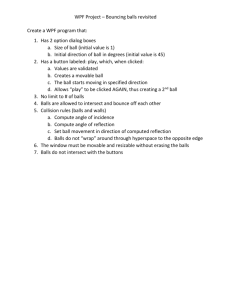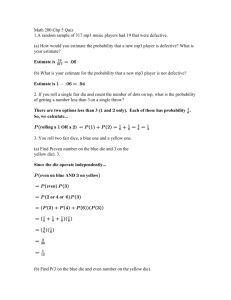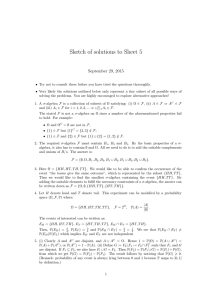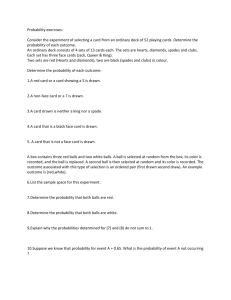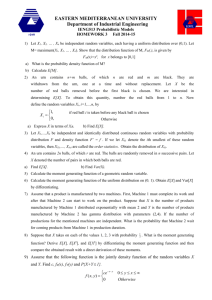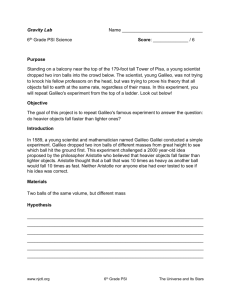Solutions to the HW4 problems (from lecture 5)
advertisement
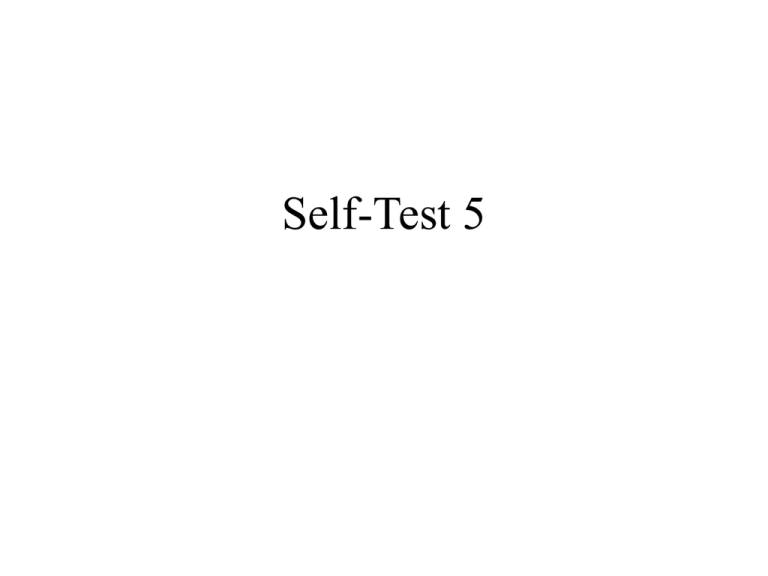
Self-Test 5 Problem 1: Box 1 contains 3 red and 5 white balls, while box 2 contains 4 red and 2 white balls. A ball is chosen at random from the first box and placed in the second box without observing its color. Then the ball is drawn from the second box. Find the probability that it is white. Solution: W1=“a white ball was chosen from the Box 1”; P(W1) = 5/8; R1 = “a red ball was chosen from the Box 1” ; P(R1) = 3/8; W2 = “a white ball was chosen from the Box 2” The probability of W2 depends on the previous step. In fact, W2 can be presented as a union of two mutually exclusive events depending on the outcome of the first step: W 2 (W 1 W 2) (R1 W 2) Fig.1 Boxes 1 (grey) and 2 in the initial state Fig.2 Box 2 depending on the outcome of the first step P(W2) = P(W1)*P(W2|W1) + P(R1)*P(W2|R1)= (5/8)* (3/7) + (3/8)*(2/7)= 21/56 = 3/8. Problem 2: A friend rolls two dice and tells you that there is at least one 6. What is the probability that the sum is at least 9? A= “ at least one 6”= orange + yellow; P(A) = 11/36. B= “ the sum is ay least 9”= red + green. AB= red; P(AB) =7/36. P(B|A) = P(AB)/P(A)= 7/11. 1 2 3 4 5 6 1 2 3 4 5 6 11 21 31 41 51 61 12 22 32 42 52 62 13 23 33 43 53 63 14 24 34 44 54 64 15 25 35 45 55 65 16 26 36 46 56 66 Some difficulties could be caused by the “cards” problem. Problem 3 We draw 4 cards out of deck of 52. Find the probability that all four values are different given that (a) all four cards belong to different suits (b) We drew two spades and two hearts. case (a). Events: S=“All four suits are different”; V=“All values are different”. P(S) = 134/C52,4=0.1055; P(VS)= 13*12*11*10/ C52,4=0.0634 P(V|S) = P(VS)/P(S)=0.601 Case (b) B= “Two spades and two hearts”. P(B) =C13,2C13.2/C52,4. P(SB) =C13,2C11,2/C52,4; P(V|B) = P(SB)/P(B)=0.705 Problem 4 An urn contains 8 red, 7 blues and 5 green balls. You draw out two balls and they are different color. What is the probability that the two balls were red and blue. B=“The balls have different color”; A =“ One is red and the other is blue” P(B) = 1- p(Bc) = 1- [P(both red) + P(both blue) + P(both green)]= 1- (8/20)(7/19)-(7/20)(6/19)-(5/20)(4/19) = 131/190. P(A)=(remember that the order can be different !) = (8/20)(7/19)+(7/20)(8/19) = 28/95. Notice now that AB, meaning that AB=A. As a result, P(A|B)=P(A)/P(B)= 56/131= 0.428 5. Suppose 60% of the people subscribe to newspaper A, 40% to newspaper B and 30% to both. If we pick a person at random who subscribes to at least one newspaper, what is the probability that he subscribes to newspaper A? A = subscribing to A; P (A) = 0.6 B = subscribing to B. ; P (B) = 0.4 L1 = AUB - at least one newspaper. P (L1) = P (A) + P (B) – P (AB) = 0.6 + 0.4 - 0.3 = 0.7; P (A|L1) = P (A*L1)/P (L1) ; How to find P(A L1)? It is clear from the picture that AL1=A. P(AL1) = 0.6; P(A|L1) = 0.6/0.7= 0.86 A AB B L1= A U B Sample space


